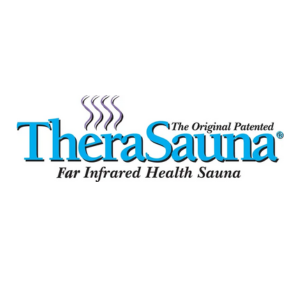DOS AND DON'TS
OF BUYING A HOME SAUNA
Have you been considering buying a home sauna to take your health, wellness, and happiness to the next level? If so, you’ve likely got a lot of questions and concerns, like: which type of sauna should you buy? Should you get one inside your house or one that can stand in the yard? Are there any safety concerns related to home saunas?
With this article, we hope to not only ease your concerns about owning a home sauna, but also to share the “dos and don’ts” you should consider before spending your money, so you can be confident you’re getting the right home sauna for you.
Pressed for time? No worries!
Click the button, and we'll send the Ultimate Do's and Don'ts Guide directly to your inbox.
DO: KNOW THE DIFFERENCE BETWEEN INDOOR AND OUTDOOR HOME SAUNAS
Choosing whether to get an indoor or outdoor sauna, as well as which design you want, will depend on any number of factors.
Three of the most important are:
-
Heat Source: Do you want the heat, natural wood smell, and authenticity of a traditional wood-burning sauna? All wood-burning saunas are for outdoor use only. Traditional saunas with electric stoves can be used indoors or outdoors as long as you have the proper hookups. Or maybe you want the cooler, less intense experience of an infrared sauna? If so, your infrared sauna should be set up indoors only.
-
Style and Design: Are you looking for something traditional and rustic, or modern and automation-ready?
-
Size and Capacity: How many people will regularly be using the sauna together? Home saunas come in 5 different sizes: 1, 2, 4, 6, and 8+ person capacities.
Indoor saunas tend to be more compact, built to fit into the smaller spaces inside people’s homes, and as a result, are generally less varied in their designs, sticking to convenient cabin shapes.
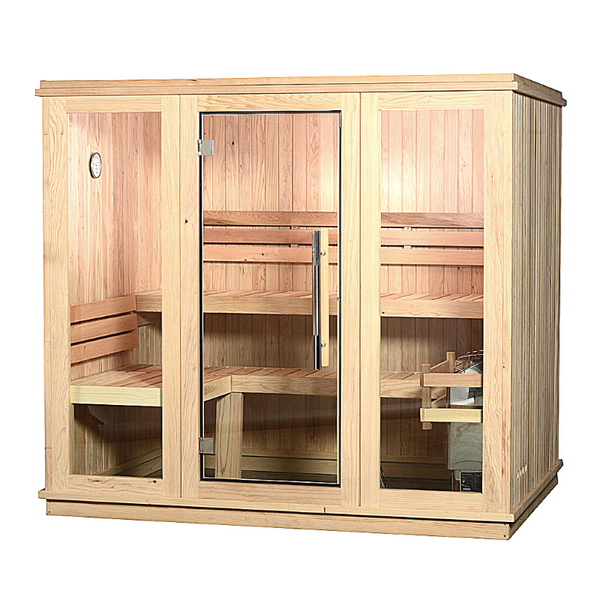
Outdoor saunas tend to be more spacious, and offer far more in the way of variety of shape and design. Sauna designs that are readily available for outdoor use include:
-
Barrel
-
Pod
-
Luna
-
Kota
-
Eagle’s nest
Though keep in mind, any of these saunas can be installed with an electric stove and used indoors, space permitting.
DO: CONSIDER THE BEST PLACE TO PUT AN INDOOR SAUNA
When deciding where to place your indoor sauna, try to think beyond the most obvious places. Choose a position that will save you money and ensure your safety.
By placing your indoor sauna close to an electrical outlet, you will save money by not having to install a new outlet or run long cords. Some sauna heaters must be wired directly into your electrical board, so finding a place close to that could be helpful.
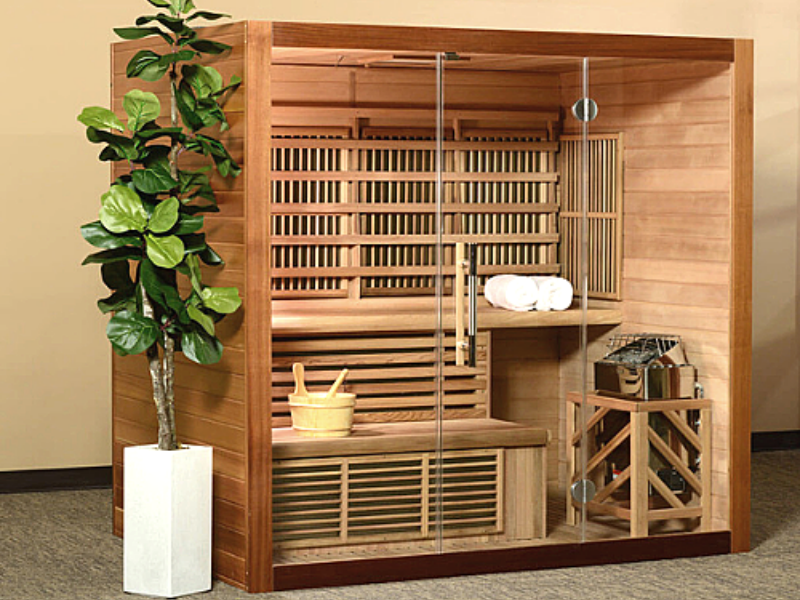
Spaces in the average home that are perfect for installing an indoor sauna include basements, garages, unused rooms or corners, bathrooms, and closets. Some notes on installing a sauna in your basement:
BASEMENT
Installing an indoor sauna in your basement saves on living space, creates a haven away from the rest of the home, but still in close proximity, and ensures privacy for the sauna occupant. Some notes on installing a sauna in your basement:
-
Do not install your home sauna in your basement if there is a problem with dampness. A sauna should be installed in a dry space with a flat floor.
-
Do not worry if your basement is not heated, and is much colder than the rest of your house. Both indoor and outdoor saunas are designed to withstand the drastic changes in temperature.
-
If your basement is very cold in winter, you can expect the warm up time to be a little longer than for saunas in temperature-controlled areas.
-
Placing your sauna in a corner will help with insulation, as the two walls that are already present will keep some of the cold air away.
-
Measure the area you have chosen for your sauna before choosing which sauna to get. This way you will avoid buying a sauna that is too large or the wrong shape for the space, and having to rethink your entire plan on the fly.
-
Electric-stove saunas and infrared options are your best choices for this placement.
-
Hire a professional to install the wiring for your sauna heat generator.
GARAGE
Choosing to install your sauna in the garage will fit most of the points listed above for basement installations, but garages have a few added advantages, such as extra space, plenty of air, which means minimal need for ventilation, and the fact that you could simply place a drip tray to catch any condensation from the sauna, rather than needing to install a drain.
UPSTAIRS
Should you have a perfect little unused room upstairs, there’s nothing stopping you from using that space for your sauna. Pre-built saunas are lightweight and are designed to be easily assembled with ease.
FLOOR OPTIONS
Indoor saunas can be placed on just about any flooring surface, except, as mentioned above, on carpeting. Not only could placing your sauna on a carpet become a fire hazard, but it would also be almost impossible to keep clean. Moisture, sweat, and dirt from your feet would gather in the carpeting, causing long term staining and discoloration, and if you ever wanted to move your sauna, your carpet would be left with unsightly rug indentations.
-
Concrete
-
Tile
-
Laminate
-
Ceramic
-
Vinyl
Indoor saunas are built for floor placement, but if you don’t like the look of your sauna with the same floor as the rest of the room, there are plenty of options for beautifying the floor space of your sauna, like one of our indoor sauna floor kits.
DO: CONSIDER THE REASONS TO GET AN OUTDOOR SAUNA
When choosing to buy a home sauna, many people forget that they have more space than just inside their homes. Placing a pretty wooden sauna in your yard can add a little bit of rustic beauty and charm, while saving floor space in the house, and increasing the value of your property.
If you are a fan of a traditional wood burning sauna, placing it outdoors is your best and safest bet. Having a sauna in your yard offers a quick getaway from the home without leaving your property, and offers more uses than an indoor sauna. For example, you could place your sauna next to the pool, creating the perfect opportunity for a “hot sauna, cold plunge” health routine.

Built to last for decades from the most durable types of wood, an outdoor sauna will withstand sun, rain, and snow for years. Be sure to maintain your sauna which will ensure the longest lifespan. Many outdoor saunas will come with a lumber warranty to ensure your peace of mind.
Like indoor saunas, outdoor saunas must be placed on a flat, even surface. When placing your outdoor sauna, place it on a wooden deck, a stone-paved area, concrete, or pressed gravel.

The exception to this rule is the barrel sauna, which comes with molded cradle supports. These saunas are stabilized by their own supports, and can be placed on less even ground, like grass or bare earth.
Can't finish our complete guide right now?
Press the button below, and we'll send you the essential Do's and Don'ts guide for easy reference later.
DON'T CHOOSE YOUR SAUNA TOO HASTILY
If you’re really excited about buying a sauna for your home and keen to get started on your new health routine, it can be easy to make the mistake of buying the first pretty sauna you see. We recommend that you reign yourself in, and take some time to make sure you choose the right sauna for your needs. Think carefully about the following questions before deciding on a sauna:
-
What are your primary health goals? Are you looking to detox and lose weight, or just a place for rest and relaxation? Do you want the high heat of a traditional sauna, or would you prefer the direct, mild heat of infrared saunas? If you buy too quickly, you’ll never know what options are available to you, and you may not get the best benefits for your situation.
-
How many people will need to use the sauna? As mentioned above, saunas come in various sizes and capacities, and you will want to make sure that the sauna you buy is not too small or large for your needs. Buying a sauna that is too small will leave you feeling cramped and claustrophobic, which defeats the purpose of relaxing in a sauna. Buying a sauna that is too large for your needs might take up too much space and use too much energy.
-
Who are the primary users going to be? Will you be sharing the sauna with your spouse or your friends? Will the kids use it, too? Or will you be using the sauna mostly alone? If so, there are some lovely 1 to 2 person saunas available, such as the Almost Heaven Logan 1-Person Indoor Sauna. Or, if you’re looking for as much space as possible, the 8-person Lewisburg Outdoor Sauna should do the trick.
DON’T: FORGET YOU CAN CUSTOMIZE YOUR SAUNA
To improve your experience and the health benefits you gain from your sauna, be sure to consider some must-have extras for the most relaxing experience.
Boost your sauna’s ability to help you relax, minimize pain, and even fight off sickness with some of these upgrades:
-
A salt wall panel will help revitalize body and soul, creating a peaceful, tranquil environment, and a state of mind to match, all while boosting your immune system, improving sleep, and cleansing the respiratory system. REad this article to learn more: “Does Himalayan Salt Actually Have Health Benefits?”
-
To ensure you don’t overstay your time in the sauna and end up dehydrated, consider the Baltic Leisure Sand Timer to keep track of your sessions.
-
Aromatherapy essential oils can help with relaxing your muscles, soothing your joints, and improving skin health, respiration, and digestion.
DO: GET ANSWERS TO YOUR SAFETY CONCERNS
You might have a lot of questions about the safety of having a sauna on your property. The good news is, with the evolution of the modern sauna, the advantages of heat therapy are brought right to you, without any cause for concern. Just follow our tips to ensure that your sauna is installed correctly and you will have no safety hazards.
FIRE OR ELECTRIC HAZARD
When installing any saunas that use electric stoves, always be sure to hire a professional electrician to ensure that the wiring is done correctly and that the sauna is receiving the correct power input.
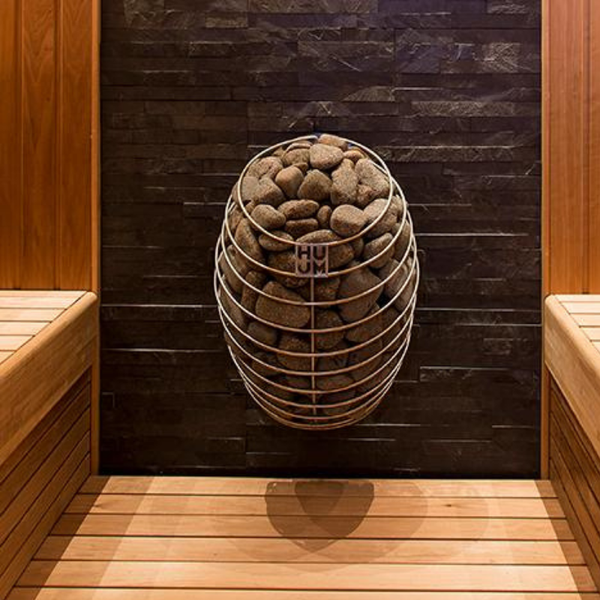
To avoid safety issues, do not place your indoor sauna on carpeting. Stick to concrete, tile, laminate, ceramic, or vinyl. Place both indoor and outdoor saunas on a flat, even surface.
FLOODING
Flooding from your sauna should be no concern at all – the indoor and outdoor saunas we sell do not need water to function. At most, you might want to pour a ladle full of water onto the sauna rocks of your traditional sauna to create steam, but this amount of water will certainly not cause any harm.
Further, you don’t need to worry about your house being damaged by humidity from your indoor sauna. All saunas are properly insulated to ensure no moisture escapes, so your home is completely protected.
TEMPERATURE
Due to the insulation and professional design of prebuilt indoor saunas, the temperature inside your sauna will have no effect on the temperature in your home.
Want to revisit the guide later?
Don't worry, we've got you covered! Click below, and we'll email you the Ultimate Do's and Don'ts Guide for your convenience.
IN CLOSING
For years of safe operation and therapeutic enjoyment of your sauna, be sure to follow the “dos and don’ts” of buying a home sauna outlined in this article.
Don’t be too hasty choosing a sauna, and don’t choose a sauna based on looks. Do keep in mind your health goals, preferences in terms of heating, and how many people are likely to use the sauna at a time. Choose a sauna that will meet all these needs, as well as your own aesthetic preferences.
Whether you choose to place your sauna in a well-used room indoors, in the basement tucked out of sight, or as a centerpiece in your garden, a home sauna will add rustic beauty to your home, and a healthy new habit to your life.

About the Author
Adam Fromson
Adam Fromson, co-founder of My Sauna World, loves saunas and their transformative health benefits. With years of experience exploring sauna culture and its impact on health and wellness, Adam is passionate about helping others discover the life-changing benefits of saunas for themselves.
Let customers speak for us
from 385 reviews
Good communication, easy delivery, easy set up, easy operation, great value. Recommended!
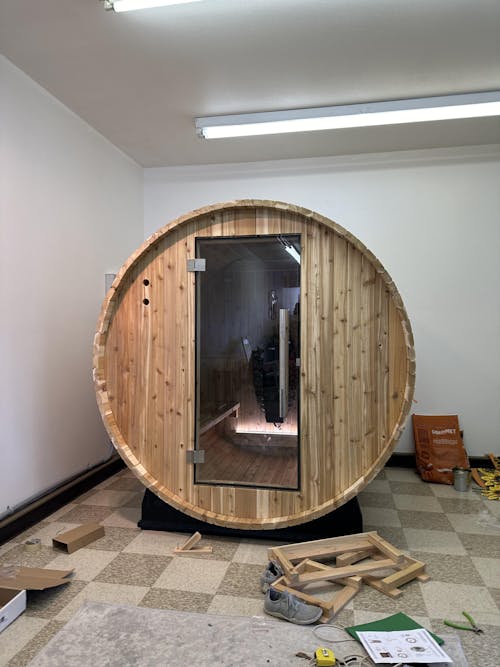
We ordered the 4 person barrel sauna and love it! We wanted a little extra space for the 2 of us/guests and it’s great. We could definitely fit 4 people in it if we needed. We use it every single day. It took about 10 weeks to get here because they build it specifically for the order. Putting the barrel together was fairly easy with 2 people. The electrical and the heater definitely required an electrician to install as we could have not done it alone.
We ordered the biggest heater (harvia spirit 8kw) and it heats up the sauna in about 15 mins inside our 40-50° garage. Overall this style of sauna is hotter and you sweat a lot faster than in an infrared sauna. I truly 10/10 recommend!
Pic is of us in the middle of building it.
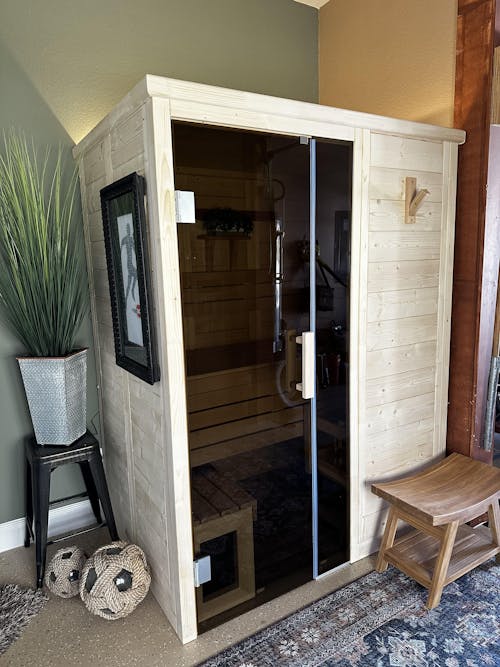
Took me about 6 hours over 2 evenings to assemble almost all by myself. Had a pro run a new circuit from my panel. Very well made and assembly was straightforward. Heater is well sized and reaches operating temperature in under 30 minutes.

Great sauna very easy to assemble

The salt panel was a great addition to our Madison Sauna. It has excellent grain which is accented by the amazing color lights that glow through the panel. Also when you hit the rocks with a splash of water you can feel the heat bounce off the panel. Great addition if you are considering this option.
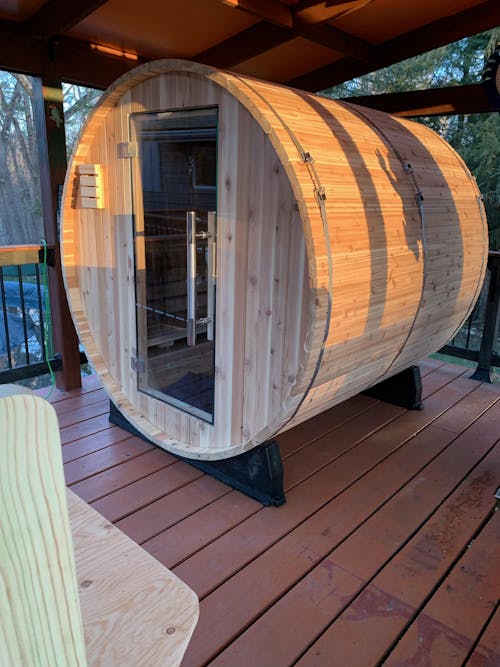
We can say enough about Sauna World there customer support is great! Our Pinnacle Sauna from Almost Heaven is epic.
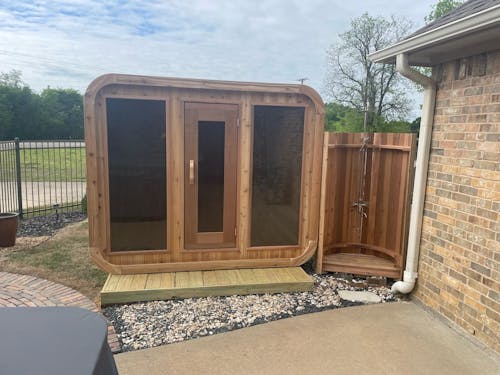
The finish and quality is outstanding and it was quick and easy to assemble.

We are thrilled with our mini pod!! It came well shipped and our friend assembled it in 11 hours! Wow! We cannot wait to get healthy and sauna it up!

Beautiful sauna!!! Much easier than I expected to assemble, took a total of 4 hours. Can't wait to get warm by the pool on those cool evenings. Customer service was excellent..

Purchased a 2 person Almost Heaven barrel sauna and were delighted with the product. The order process was quick and easy, the sauna arrived on-time, installation was simple, following the provided instructions, and the sauna is extremely high quality. We’ve used it daily for over 2 weeks and quite frankly I don’t know how we lived without it. If I had it to do over again I wouldn’t change a thing... except maybe purchasing a 4 person model to easier share with friends!

Great Customer Service and a breeze to put together.Excellent shipping and the Sauna is top notch, couldn’t be happier




























